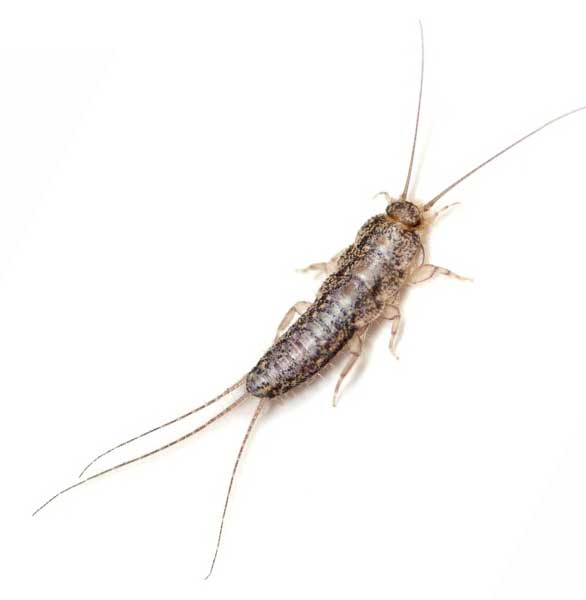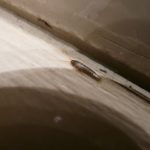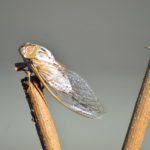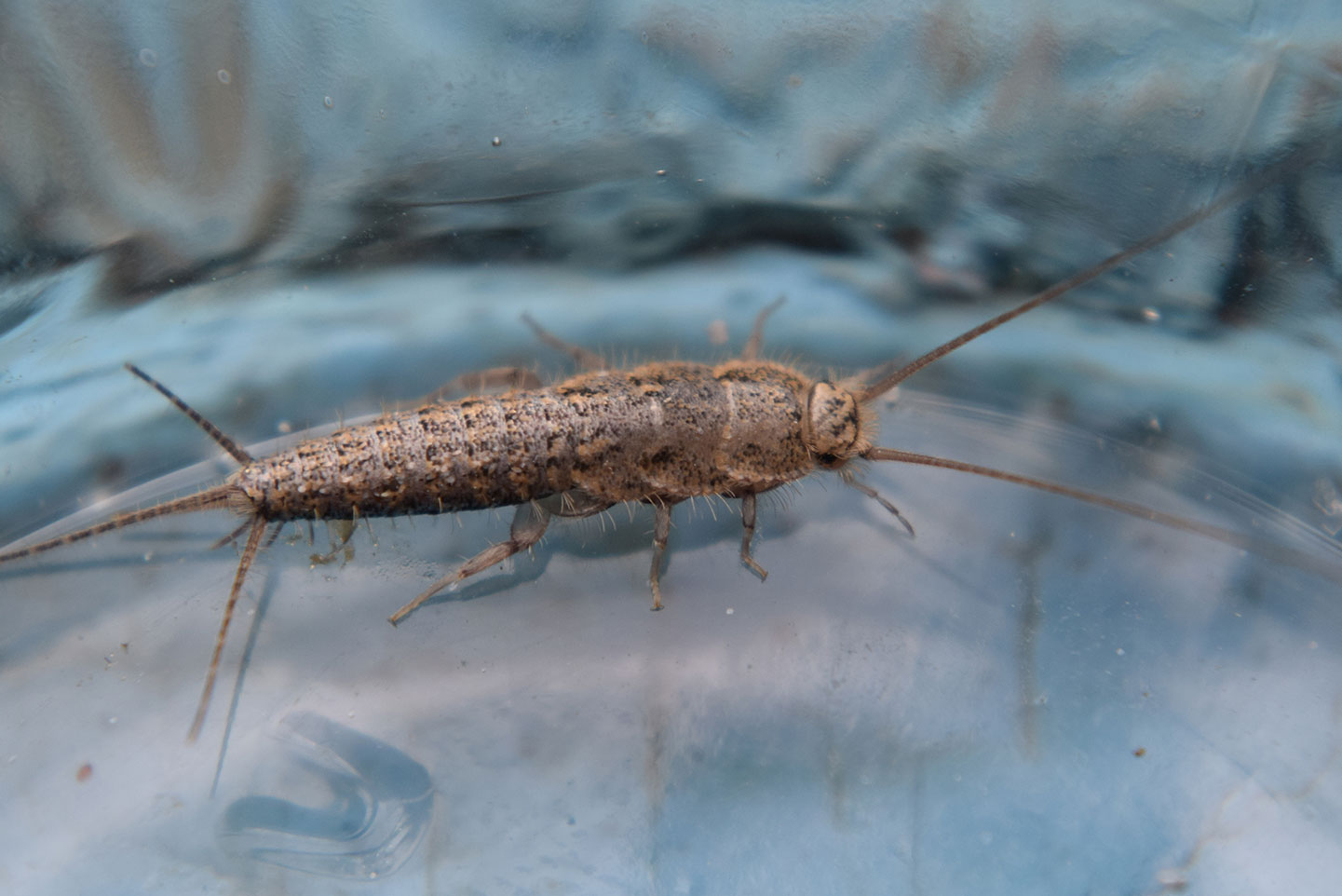(Lepisma saccharina)
Description
Silverfish are a species of slender, wingless insects having three tail bristles. They are silver or pearl-gray in color with a flat body covered in tiny glistening scales. They are shaped like a teardrop and are about 12 mm to 15 mm long, or about ½ inch in length.. They look similar to shrimp and crustaceans.

Additional Information
Habits & Behavior

Silverfish are known to be elusive creatures. They are nocturnal, so you may not see them lurking around the home. They move swiftly to escape detection but are unable to climb smooth surfaces. Silverfish live in dark, moist environments with high humidity.
They primarily live indoors, but can be found outdoors as well. When outside, they live primarily under rocks, leaves, and tree bark. When indoors in buildings, silverfish can be found in bathrooms, kitchens, attics, and basements. These fast insects can also be found in the cracks and crevices of walls and floors, as well as behind baseboards, windows, door frames, and bookcases.
Silverfish are shy creatures. They are scared of humans and try to avoid them whenever possible. They cannot fly or bite, but they can run quickly.
Food
Silverfish are generally scavengers that will eat virtually anything available. They love carbohydrates, such as flour and rolled oats, as well as coffee and sugar. They also enjoy eating non-traditional foods such as soap, hair, dandruff, dust, glue, clothing, silk, cotton, and linen. They may even eat other silverfish.
These insects, however, prefer to feed on carbohydrates and proteins. When outdoors, silverfish mainly consume vegetable matter. Silverfish living in homes among humans often eat common household items such as books, documents, photographs, and wallpaper. They are especially fond of sugar and starch and are known to raid kitchen pantries. Even though silverfish love to eat, they can survive without food for as long as one year.
Reproduction
The reproductive process for silverfish begins with an elaborate mating ritual performed between males and females. The insects touch their antennae together. The female then flees, with the two reuniting. The silverfish then stand side by side while the male vibrates his tail. At the end of the ritual, male silverfish deposit a sperm capsule that the female absorbs for fertilization.
Female silverfish lay their eggs, often in small groups, within tiny cracks and crevices. The eggs typically hatch in 3-6 weeks. Silverfish reproduce slowly, with the average female silverfish laying up to 100 eggs during her life. Silverfish have a lifespan ranging from 2-8 years.
The silverfish process from egg to adult usually takes about four months. Silverfish are hardy and can thrive in almost any environment, although humid conditions are preferable. Female silverfish tend to produce 1-3 eggs per day, although they can lay clusters of up to 20. They like to deposit eggs in cracks around the inside of a home or attic. They can produce eggs all year long, which is rare for insects.
Silverfish eggs develop through three stages: egg, nymph, and adult. Newly hatched silverfish look like miniature adult silverfish and acquire the distinctive shiny appearance of adults within 40 days. It can take two years for silverfish to mature into adults and they can live roughly three years.
Signs
Do you have silverfish in your home? Here are the signs:
- Sightings. If you see silverfish, this is an obvious sign that they are around. However, one or two silverfish does not necessarily mean you have an infestation. Be on the lookout for them in cracks and crevices in your home. They are commonly out and about at night.
- Stains. Silverfish can leave yellow stains on household items due to their secretions. You will commonly find these stains on books, paper, cardboard boxes, and fabric including clothes. This secretion can also leave stains on walls and floors, so consider storing items in plastic bins.
- Damage. Besides stains, you may also see damage such as torn pages in books or holes in clothing. If you’re not sure what happened to your household items, silverfish could be to blame.
- Droppings. Droppings can alert you to a silverfish infestation. These are small, round, and black, like tiny peppercorns. They are likely to be found in damp and dark locations of the home, where silverfish like to hide. These places include kitchens, bathrooms, garages, and basements.
- Molted skin. Silverfish molt multiple times throughout their lives, so you may see shed skin and scales in your home. These skins are small, though, so they often go unnoticed. Look for them in bathrooms, kitchens, and basements.
Dangers
Silverfish are not dangerous to humans. They do not bite or carry any diseases. If you are worried about your pets eating silverfish, you will be happy to know that they won’t hurt your dog or cat.
However, these tiny insects can infest a home, destroy property, and trigger allergies. They can contaminate food with their droppings, so if you see silverfish in your food, throw it out.

Silverfish feed on starchy materials and items that are high in protein. They love to chew and can cause damage to books, stored food, and clothing.
Contact Us Today
Silverfish are not dangerous to humans or pets, but you still don’t want them in your home. While DIY solutions can provide temporary, get rid of these pests for good with professional help.
Stride Pest Control can help you get rid of silverfish and other annoying pests. Enjoy your home and yard once again. We offer the best possible service in the nicest possible way. Schedule a free inspection by filling out the online form or calling (512) 777-1339 (Austin) or (210) 547-8410 (San Antonio).
Average number of years a silverfish will live
3-6
Length of time a Silverfish can go without eating
1 Year
years Silverfish predate dinosaurs
100 MM
Height silverfish can vertically jump
2 Ft.
Get a FREE Consultation


